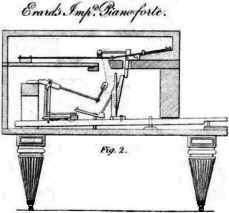home
| Pianoforte-makers
in England
ERARD
in
London ![]()

![]()
"A.D. 1794, October 17.-N° 2016. - ERARD, SEBASTIAN. - Improvements in
the construction of harps and pianofortes, both large and small, and
which improvements may also be applied to all kinds of instruments where
keys are used.
Newton's London Journal of Arts and Sciences, Volume 12, 1826, p. 413
Erard's Inventions for Piano Fortes and Harps. "NOTICE is hereby given, that Pierre Erard, of No. 18, Great Marlborough-street, in the county of Middlesex, harp and piano forte-manufacturer, intends forthwith to apply to His Majesty in Council, for a prolongation of his term of sole using and vending the inventions described in the letters patent under mentioned, that is to say; certain letters patent, bearing date the 22d December 1821, for that part of the United Kingdom of Great Britain and Ireland called England, the dominion of Wales, and town of Berwick-upon-Tweed, for an invention of “certain improvements on piano fortes and other keyed musical instruments;” also certain other letters patent, bearing date the 6th April 1822, for that part of the United Kingdom of Great Britain and Ireland called Scotland; and eertain other letters patent, bearing date the 14th December 1822, for that part of the United Kingdom of Great Britain and Ireland called Ireland, both or the same above-mentioned invention; also certain other letters patent, bearing date the ?th January 1825, for that part of the United Kingdom of Great Britain and Ireland called England, the dominion of Wales, and town of Berwick-upon-Tweed, for an invention of “certain improvements on piano fortes;" and certain other letters patent, bearing date the 20th February 1827, for that part of the United Kingdom of Great Mritain and Ireland called England, the dominion of Wales, and town of Berwick-upon-Tweed, for an invention of “certain improvements in the construction of piano fortes;” also certain other letters patent, bearing date the 24th April 1822, for that part of the United Kingdom of Great Britain and Ireland called England, the dominion of Wales, and town of Berwick-upon-Tweed, for an invention of “certain improvements on harps;" also certain letters patent, bearing date the 12th July 1822, for that part of the United Kingdom of Great Britain and Ireland called Scotland; and certain other letters patent, bearing date the 18th October 1822, for that part of the United Kingdom of Great Britain and Ireland called Ireland, both for the same last mentioned invention." The London Gazette, 09/10/1835, p. 1863
Erard's Patents for Piano-Fortes. "NOTICE is hereby given, that Pierre Erard, of No. 18, Great Marlborough-street, harp and piano-forte-manufacturer, has, in pursuance of the public notice inserted by him in the Gazettes of the 9th, 13th, and 16th October last, and the Times, Morning Chronicle, and Morning Post newspapers, published in London the 9th and 12th October 1835 respectively, presented a petition to His Majesty in Council, praying His Majesty to grant him a prolongation of his term of sole using and vending the several inventions described by him in his specifications to the several letters patent, bearing date respectively the 22d December 1821, the 6th April 1822, the 14th December 1822, and the 5th January 1825; and that the said Pierre Erard is about forthwith to apply to the Right Honourable the Lords composing the Judicial Committee of His Majesty's Honourable Privy Council to fix an early day for the hearing of the matters contained in his said petition; and all persons desirous of being heard in opposition to the player of his said petition are hereby required forthwith to enter a caveat at the Privy Council Office, as directed by the Statute 5 and 6 William 4. cap. 83. - Freshfield and Sons." The London Gazette, 01/12/1835, p. 2280
1. A method of arranging the strings of pianofortes so as to produce on the sounding-board an equal pressure, both in an upward and downward direction, and so also that the sounding part of all the strings shall lie in the same plane, which has not been hitherto managed when the pressure on the sounding-board has been equalized. This the patentee effects by passing each of the wires through holes in three studs attached to the bridge-the holes in the centre studs being made either at a higher or lower level than those in each of the other studs, so as to cause the wires in passing through the studs to make an angle with the bridge, and thus either exert an upward or downward pressure on the sounding-board. By placing the studs so as to make every alternate wire at the reverse angle to that immediately next it, the pressure on the sounding-board will be exactly balanced. 2. An arrangement for tuning the wires of pianofortes. The ends of the wires, after passing round screws the heads of which keep them from rising, are attached to slides moving in guides on the wrest plank; and these slides are actuated by screws, the turning of which in either direction tightens or slackens the wires accordingly. 3. An improved construction of hammerbutt for “Erard’s patent action,” in which a regulating screw is introduced at the hammer centre." The Mechanics' Magazine Museum, Register, Journal, and Gazette, 1852, p. 435
|
